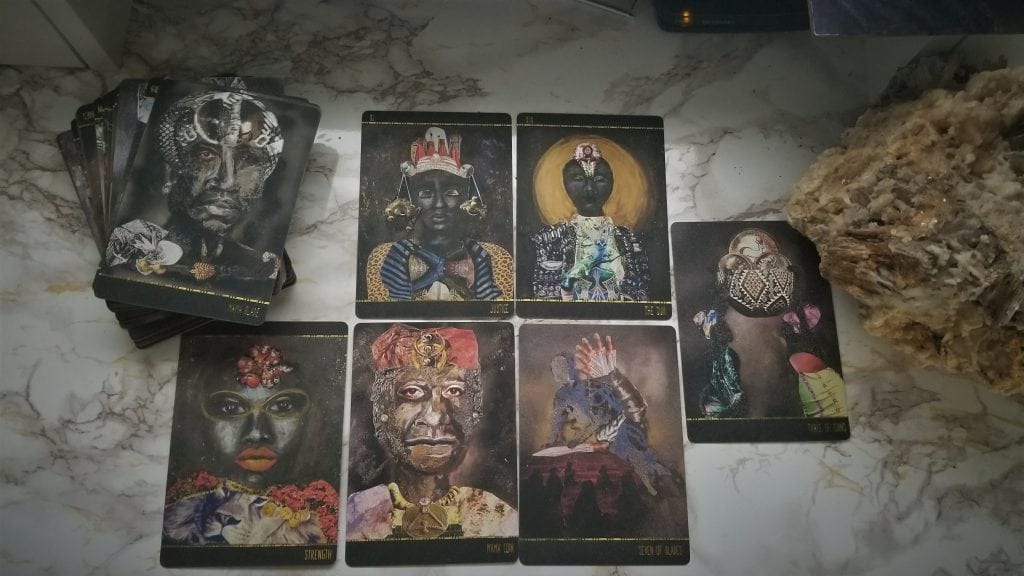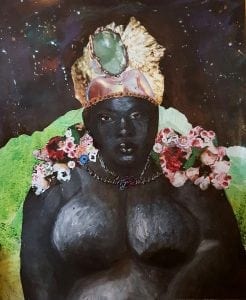
Courtney Alexander |
Creator of Dust II Onyx
The artist muses on the freedoms of being a Florida-based artist, what she loves about USF’s fine arts program and her tarot works.
By SARAH TELESCA, May 8, 2018

I chatted with Florida-based painter and artist Courtney Alexander about her tarot deck, the Florida art scene, and what she has planned for the near future.
Sarah Telesca: How do you feel the art scene in Florida is different from other places? What works for you in Florida as an artist?
Courtney Alexander: The art scene in Florida is really cool because there’s that opportunity to play — in comparison to, say, New York, where it’s about competition, the shows; it’s about the hustle and “making it” in the art world — Tampa doesn’t have that type of pressure. You have the opportunity to show in different places, be a part of a collective, do interesting things with your work — there aren’t too many things holding people back from going for things they want to try out. There’s a lot of room to breathe in the Tampa art scene.
ST: What draws you to collage?

CA: Before I graduated from the University of South Florida, I began working in collage; I was drawn to it because of artists like Wangechi Mutu and Mickalene Thomas who really opened up the world of collage for me because I saw the possibilities with mixed media. There was a freedom I found in mixed-media collage that allowed me to intuitively create, and there’s something about the resourcefulness of it, using found materials, making it come alive and giving it a story and context outside of its original intent.
ST: How did your time as a student at USF shape you as an artist?
CA: Originally I was going to go to USF for advertising. I didn’t want to be an artist; I didn’t see myself as an artist. I decided on a whim to go into the art program because I wanted to be a creative director. I approached it from this viewpoint of someone who wanted to go into advertising and the design world. So USF, being contemporary-focused, gave me the freedom to really explore and play and allowed things to surface in me that I didn’t really know were there.
I began working very loosely with paper, and then translated that into larger collage paintings where I was working with vinyl flooring, trash bags, and all sorts of other material. I ended up winning the James Rosenquist scholarship for my triptych “Percolate.” So for me, that was very validating in regard to working with mixed media and collage and made me feel comfortable continuing to go that route.
USF was a wonderful birthing ground for me as an artist. By the time I graduated, I saw myself as an artist and I decided that I would pursue a career as an artist. Dust II Onyx started six months after graduation, so things happened fast!

ST: How did Dust II Onyx: A Melanated Tarot come about, and what has been the impact on you and the community?
CA: It all just kind of happened quickly. I had been using tarot for a while, but more like apps, because I grew up in a Christian household, so for a while I was afraid of tarot. Apps became a gateway for me. When I decided to purchase a deck I realized that there were so many decks for so many types of people, but there were no decks that I resonated with, as a black person—there are decks out there that have representations of black people, but all of the tarot decks about black people & black culture were actually not created by black people. I felt an issue with that, because I thought, “How am I supposed to spiritually and emotionally connect with this deck that’s made by someone who hasn’t also lived my experience? I have those decks and they’re beautiful, effective decks, for a time, but there’s still a wedge between them and myself because they felt very researched. There was somebody who read about black culture and said, “Let me put these things together and talk about it,” and that’s not the same as someone whose entire spiritual, social, and political experience is in it.
When I first thought about the artwork I did these little ugly doodles (laughs)—I was literally going to make a little ugly doodle tarot deck—it was not in my mind at the time, like it is now. Then I started going through this big, distinct shift. I started to have dreams, the last one about death. After considering its meaning, I realized that it was just about release. Three days later I started the artwork for the cards, and I started with the death card. That was me facing my fears, whether it be change, literal death, all of those things.
I was doing like two paintings a day — in a couple of weeks I had about 20 paintings. I premiered them at a local event, and that was when I got such incredible feedback that that was when I knew that I really had something special and that I needed to take it seriously, so I did, and the rest is history. A month or so later I launched a Kickstarter and got it funded, and by March I had all these paintings, then I wrote the accompanying book in six months.
ST: It seems like the deck was almost trying to speak to you before it was created; trying to “come out.”
CA: It definitely has a power and energy of its own, even through the creation process it was very intuitive. I’m re-experiencing this work the same way that everyone else is. I think that’s why it resonates so deeply with people, and that’s why they feel something visceral from it; there’s a real energy there because of how it came about. It really was intuitive and magical in its own way. It’s so satisfying for me to hear people say “ I look at your work and I feel something; my soul feels something.”
I want to continue using divination as a medium for my work and continue to push the boundaries, whether its using digital media, sculpture, installation, performance, bringing all of these other elements into divination to create these other artworks because there’s something about using the divination system that makes it more personal and attainable than just having to view it on the wall. It’s different when you publish a divination product, people who are not necessarily entrenched in the art world can find a way to enjoy art and have a connection to it without needing the assistance of art experts, per say.
ST: Is there a certain card in the deck that you’re particularly drawn to as of late?

CA: Lately I would say that I’m definitely drawn to “When I asked them who we were? They said we ARE the womb” [which is the painting] Mama Gourd. It’s one of the core cards that has the eyes of Nikki Giovanni and the face of Missy Elliot. The card is very emotional and creative, I feel like Nikki Giovanni and Missy Elliot represent how a seemingly intense energy can be channeled into something completely innovative and creative.
I want to find a way to channel that energy to where it can exist and not be rigid, but continue to direct everything I do with purpose. I am a purpose-driven artist, in that sense. I have fun and experiment, I’m very entrepreneurial, but my entrepreneurship does not trump who I am as an artist and what I put out into the world as an artist and as someone who is trying to affect change and inspire people, even with this deck, finding ways to bring social activism to it and finding new ways for people to interact with art and use it to inspire social change, not just giving the message, but being a tool for it as well.
Courtney is currently working on a piece for the show “Altar of Stars” in conjunction with Simone Small. Check back at her website, courtneyalexanderstudio.com for more details.




